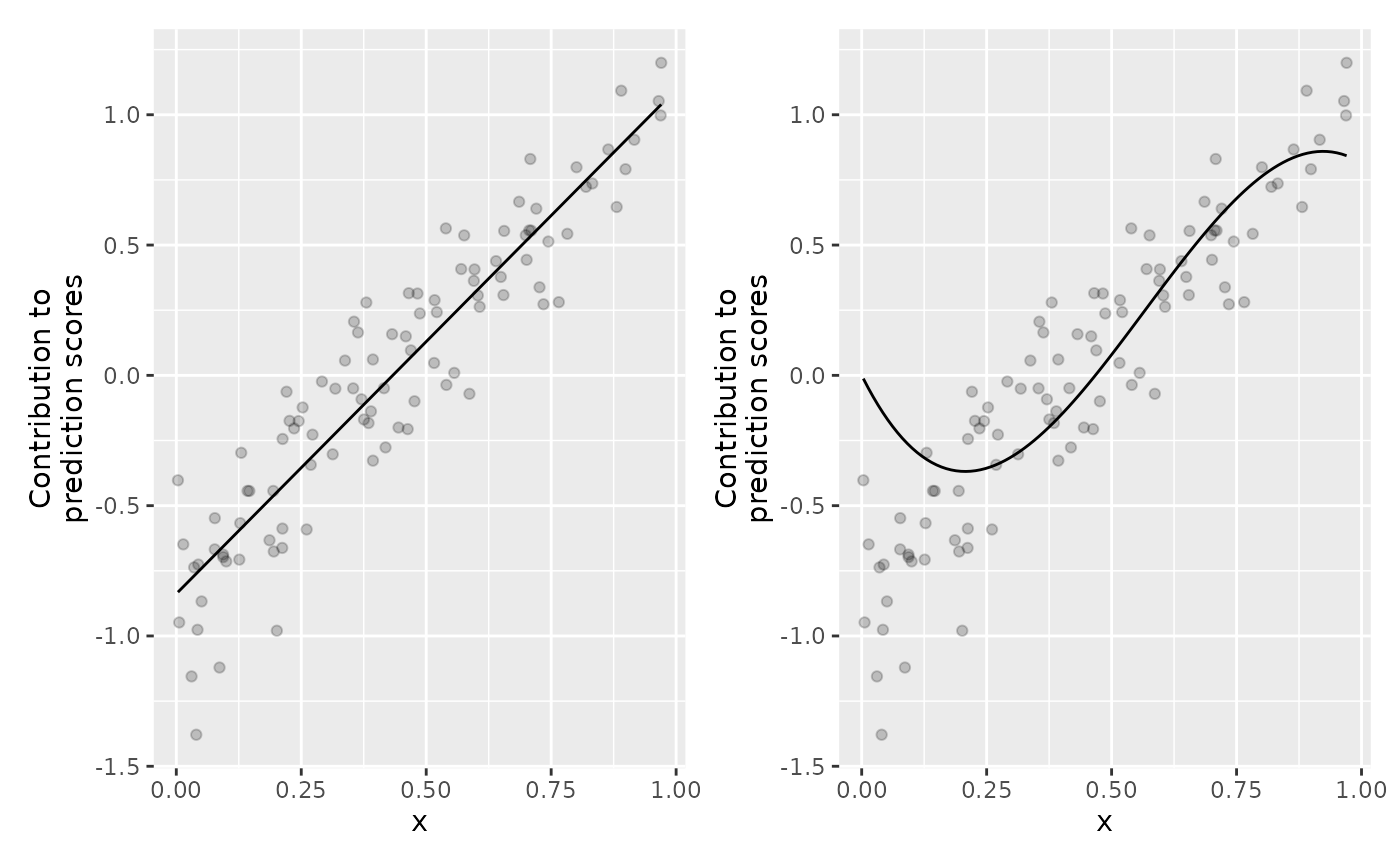[BaselearnerPolynomial] creates a polynomial base learner object.
The base learner takes one feature and calculates the polynomials (with
intercept) \(1 + x + x^2 + \dots + x^d\) for a given degree \(d\).
Format
S4 object.
Arguments
- data_source
(InMemoryData)
Data object which contains the raw data (see?InMemoryData).- blearner_type
(
character(1))
Type of the base learner (if not specified,blearner_type = paste0("poly", d)is used). The unique id of the base learner is defined by appendingblearner_typeto the feature name:paste0(data_source$getIdentifier(), "_", blearner_type).- degree
(
integer(1))
Polynomial degree.- intercept
(
logical(1))
Polynomial degree.- bin_root
(
integer(1))
The binning root to reduce the data to \(n^{1/\text{binroot}}\) data points (defaultbin_root = 1, which means no binning is applied). A value ofbin_root = 2is suggested for the best approximation error (cf. Wood et al. (2017) Generalized additive models for gigadata: modeling the UK black smoke network daily data).
Usage
BaselearnerPolynomial$new(data_source, list(degree, intercept, bin_root))
BaselearnerPolynomial$new(data_source, blearner_type, list(degree, intercept, bin_root))Methods
$summarizeFactory():() -> ()$transfromData(newdata):list(InMemoryData) -> matrix()$getMeta():() -> list()
Inherited methods from Baselearner
$getData():() -> matrix()$getDF():() -> integer()$getPenalty():() -> numeric()$getPenaltyMat():() -> matrix()$getFeatureName():() -> character()$getModelName():() -> character()$getBaselearnerId():() -> character()
Examples
# Sample data:
x = runif(100)
y = 1 + 2*x + rnorm(100, 0, 0.2)
dat = data.frame(x, y)
# S4 wrapper
# Create new data object, a matrix is required as input:
data_mat = cbind(x)
data_source = InMemoryData$new(data_mat, "my_data_name")
# Create new linear base learner factory:
bl_lin = BaselearnerPolynomial$new(data_source,
list(degree = 1))
bl_cub = BaselearnerPolynomial$new(data_source,
list(intercept = FALSE, degree = 3, bin_root = 2))
# Get the transformed data:
head(bl_lin$getData())
#> [,1] [,2]
#> [1,] 1 0.70828422
#> [2,] 1 0.70091819
#> [3,] 1 0.22057668
#> [4,] 1 0.07709625
#> [5,] 1 0.58647345
#> [6,] 1 0.35549948
head(bl_cub$getData())
#> [,1] [,2] [,3]
#> [1,] 0.003279946 1.075805e-05 3.528582e-08
#> [2,] 0.110713932 1.225757e-02 1.357084e-03
#> [3,] 0.218147917 4.758851e-02 1.038134e-02
#> [4,] 0.325581902 1.060036e-01 3.451285e-02
#> [5,] 0.433015887 1.875028e-01 8.119167e-02
#> [6,] 0.540449873 2.920861e-01 1.578579e-01
# Summarize factory:
bl_lin$summarizeFactory()
#> Linear base learner factory:
#> - Name of the used data: my_data_name
#> - Factory creates the following base learner: poly1
# Transform "new data":
newdata = list(InMemoryData$new(cbind(rnorm(5)), "my_data_name"))
bl_lin$transformData(newdata)
#> $design
#> [,1] [,2]
#> [1,] 1 -1.1363869
#> [2,] 1 -0.6597606
#> [3,] 1 0.1988824
#> [4,] 1 -0.5206944
#> [5,] 1 0.8838683
#>
bl_cub$transformData(newdata)
#> $design
#> [,1] [,2] [,3]
#> [1,] -1.1363869 1.2913752 -1.467501849
#> [2,] -0.6597606 0.4352841 -0.287183303
#> [3,] 0.1988824 0.0395542 0.007866632
#> [4,] -0.5206944 0.2711226 -0.141172025
#> [5,] 0.8838683 0.7812231 0.690498330
#>
# R6 wrapper
cboost_lin = Compboost$new(dat, "y")
cboost_lin$addBaselearner("x", "lin", BaselearnerPolynomial, degree = 1)
cboost_lin$train(100, 0)
#> Train 100 iterations in 0 Seconds.
#> Final risk based on the train set: 0.021
#>
cboost_cub = Compboost$new(dat, "y")
cboost_cub$addBaselearner("x", "cubic", BaselearnerPolynomial,
intercept = FALSE, degree = 3, bin_root = 2)
cboost_cub$train(100, 0)
#> Train 100 iterations in 0 Seconds.
#> Final risk based on the train set: 0.065
#>
# Access base learner directly from the API (n = sqrt(100) = 10 with binning):
head(cboost_lin$baselearner_list$x_lin$factory$getData())
#> [,1] [,2]
#> [1,] 1 0.70828422
#> [2,] 1 0.70091819
#> [3,] 1 0.22057668
#> [4,] 1 0.07709625
#> [5,] 1 0.58647345
#> [6,] 1 0.35549948
cboost_cub$baselearner_list$x_cubic$factory$getData()
#> [,1] [,2] [,3]
#> [1,] 0.003279946 1.075805e-05 3.528582e-08
#> [2,] 0.110713932 1.225757e-02 1.357084e-03
#> [3,] 0.218147917 4.758851e-02 1.038134e-02
#> [4,] 0.325581902 1.060036e-01 3.451285e-02
#> [5,] 0.433015887 1.875028e-01 8.119167e-02
#> [6,] 0.540449873 2.920861e-01 1.578579e-01
#> [7,] 0.647883858 4.197535e-01 2.719515e-01
#> [8,] 0.755317843 5.705050e-01 4.309126e-01
#> [9,] 0.862751829 7.443407e-01 6.421813e-01
#> [10,] 0.970185814 9.412605e-01 9.131976e-01
gg_lin = plotPEUni(cboost_lin, "x")
gg_cub = plotPEUni(cboost_cub, "x")
library(ggplot2)
library(patchwork)
(gg_lin | gg_cub) &
geom_point(data = dat, aes(x = x, y = y - c(cboost_lin$offset)), alpha = 0.2)

